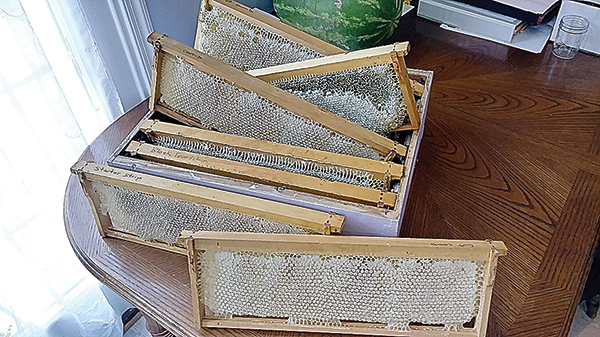
Melondy Phillips
Staff Writer
When I was young, clover honey was about the only type of honey available in our little country store. Now and then, when visiting larger towns, my parents could locate apple blossom honey. This was my favorite honey and a great treat to have since we were lucky to get a small bottle of it about once or twice a year.
I was an adult the first time I traveled to Florida. While there, I saw a different type of honey for the first time – Orange Blossom. I had to try it and I quickly fell in love – my new favorite honey.
Years later, after I began raising my own honeybees, I began to discover the minute intricacies of different types of honey.
The local foliage, weather patterns, and even the health and emotional state of the bees can make a difference in the flavor, texture and color of the honey. Yes, I said “emotional state” of the bees. I have noticed that, like people, different things will affect the happiness of my bees. Rainy days, pests, illness, uncleanliness and unwanted guests make them cranky. High honey flow, warm, clear days and a healthy laying queen produces a happy and docile hive.
While living in Virginia, our spring honey was light in color and carried a light fruity flavor from all of the spring fruit blossoms. As the year progressed, the honey darkened and incorporated a slight pungent savor with a bit of tanginess. Honey taken after goldenrod bloomed contained a bitterness I did not like. To avoid the bitterness, I always harvested my honey before goldenrod bloomed. The remainder of the late season honey I left for the over wintering bees. I would still usually take a frame or two of the goldenrod honey, for those who specifically asked for it because of their goldenrod allergies. The practice of using local honey to help allergies has been observed for many, many years. Consuming honey for allergies is only one of the many health benefits discovered for this liquid gold.
Cochrane.org states, “There is high quality evidence that honey heals partial thickness burns around 4 to 5 days more quickly than conventional dressings. There is moderate quality evidence that honey is more effective than antiseptic followed by gauze for healing wounds infected after surgical operations.”
PubMed Central’s research found that, “Only the group that ingested honey showed a significant improvement in individual AR (allergic rhinitis) symptoms” and “Honey ingestion at a high dose improves the overall and individual symptoms of AR, and it could serve as a complementary therapy for AR.” For the purposes of allergies, local honey is highly sought after.
The term “local honey” can vary from place to place. One reason people search for local honey is the desire for allergy relief. That means they are looking for some honey made from the same, or similar, foliage that is around them, which can be five miles or 150+ miles away. For instance, “local” to the Blue Ridge of Virginia may extend from lower Maryland and parts of the Eastern Panhandle in West Virginia all the way down through upper areas of North Carolina. Areas in the same grow zone where an abundance of common plant life has a wide disbursement. Specialized honeys, however, like Manuka, Tupelo and Acacia, are only available from specific localities.
Another reason to seek local honey is to know the producer; to be able to talk to the person who collected the sweet bounty. Ask them questions: when was it harvested, how was it harvested, was it heated, was anything added to it, etc. Have a supplier you can trust.
This is a multipart article that will cover what heating does to honey and the dangers of that, about fake or altered honeys, information on a dozen different types of honey, and some facts about the honeycomb itself.
Part one of six



